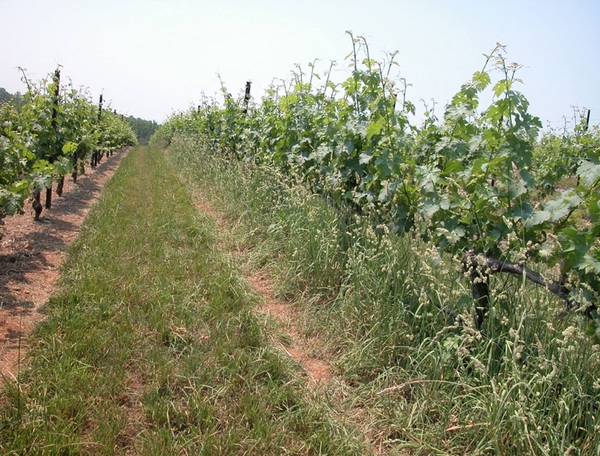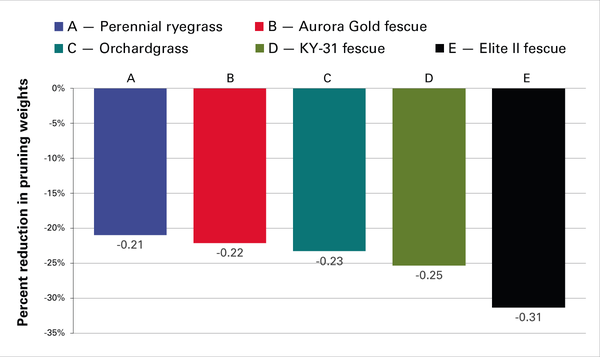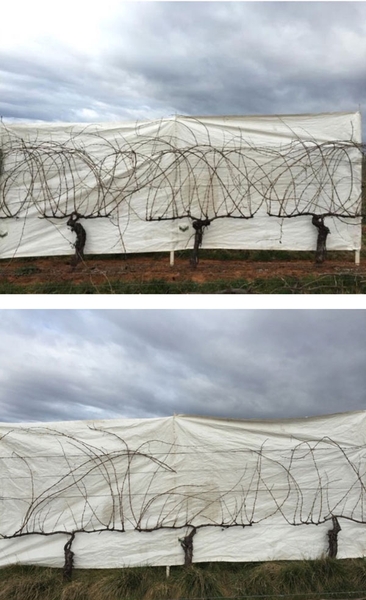Under Trellis Cover Crops
The application and management of under trellis cover crops (UTCC) can be a suitable method to achieve a range of vineyard management goals in North Carolina. Control of excessive grapevine vigor and the reduction of annual herbicide applications in vineyards are the most common reasons for considering UTCC. Appropriately implemented UTCC can also reduce erosion, increase water infiltration, and positively affect soil health and vineyard aesthetics. In this publication, we explain UTCC choices, the effects on vineyard vigor, and management practices. This publication is an addendum to Wolf & Giese (2020), who discuss general floor management strategies in vineyards in the Southeast US.
Common cover crop species used as UTCC in North Carolina are listed in Table 1, along with seeding rates and growth habit. For a grower who decides to use either a low height perennial cover crop (such as red fescue) or a taller, more vigorous grass (such as Elite-II fescue), UTCC offers a range of benefits in the vineyard. This publication highlights research at a North Carolina commercial vineyard on the impact of UTCC on grapevine vigor, yield, vine balance, and fruit chemistry, and explains UTCC management, common pitfalls, and mistakes to avoid.
UTCC to Control Vigor
Excessive vegetative growth of wine grapes occurs worldwide, and is especially problematic in North Carolina’s warm, humid growing conditions. Large, dense grapevine canopies with heavily shaded fruit and interior leaves increase humidity, limit sunlight penetration and air circulation, promote fungal disease, and have negative effects on fruit composition, yield, and wine quality (Figure 1). Many growers use costly canopy management practices such as leaf and lateral removal, hedging, shoot topping, and shoot or cluster thinning to improve the vine microclimate and to optimize the light exposure of the grapes. In addition, growers continue to limit the competition of under trellis vegetation with grapevines by repeatedly applying herbicides. As an alternative, UTCC can mitigate erosion, support soil health, reduce excessive vine vigor, and by competing with weed species, reduce vineyard applications of herbicides. The correct implementation of UTCC can substantially reduce operational costs and can optimize vine size, vigor, and berry composition.
Experiment Site and Design
A 12-year study conducted from 2005 to 2017 compared the impact of five cool season grasses as UTCC and herbicide treated vine rows on vine performance and yield. The study was conducted in a commercial vineyard in a Yadkin Valley American Viticultural Area (AVA) with Cabernet Sauvignon, clone 8 on SO4 rootstock (planted in 2000 and vertical shoot positioned (VSP)). The following perennial grasses were evaluated as UTCC: (1) Festuca arundinacea Schreb., cv. KY-31, forage-type tall fescue, (2) Festuca ovina, cv. Aurora Gold, hard or sheep fescue, (3) Lolium perenne, perennial rye grass, (4) Dactylis glomerata, orchard grass, (5) Elite II, turf-type tall fescue, and (6) herbicide treated vine rows as a control (Figure 2).
The KY-31 and Elite II fescues were superior in stand density, had the fewest weeds, and generally provided the most uniform sward over time, compared to the Aurora Gold sheep fescue, perennial rye grass, and orchard grass. Orchard grass was the most intrusive into the vines’ canopy and fruit zone, as shown in Figure 3. Generally, tall grasses such as orchard grass are less desirable for use as UTCC because they require greater attention. UTCC should not grow into the fruiting zone of a vine. In contrast, cane-pruned systems or those on vertical shoot positioning (VSP) systems, such as low growing UTCC (KY-31 or Elite II fescues), are preferable options.
| Pruning Weight | Cane Weight | Cane Length | Fruit-to-Wood Ratio | Leaf Layers | Leaf-to-Fruit Ratio* |
|---|---|---|---|---|---|
| 0.6 to 1.0 kg/m (0.2 to 0.4 lb/ft) of fruiting wire or cordon |
~ 40 gm (~1.4 oz) | 100 to 140 cm (39 to 55 in.) | 5 to 10 (lb fruit per lb of pruning weight) | 1.5 in. fruit zone | 12 to 17 leaves per 1.5 clusters or 10 to 12 cm2 per gm of fruit |
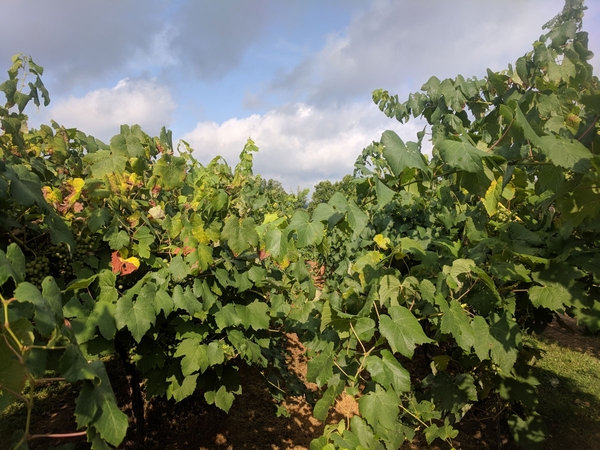
Figure 1. Excessively vigorous Riesling grapevines in a modified Geneva Double Curtain planting in North Carolina. Downy mildew (Plasmopara viticola) is evident spreading through the canopy. High vigor can lead to inaccessible row middles and high disease pressure.
Source: Mark Hoffmann, North Carolina State University
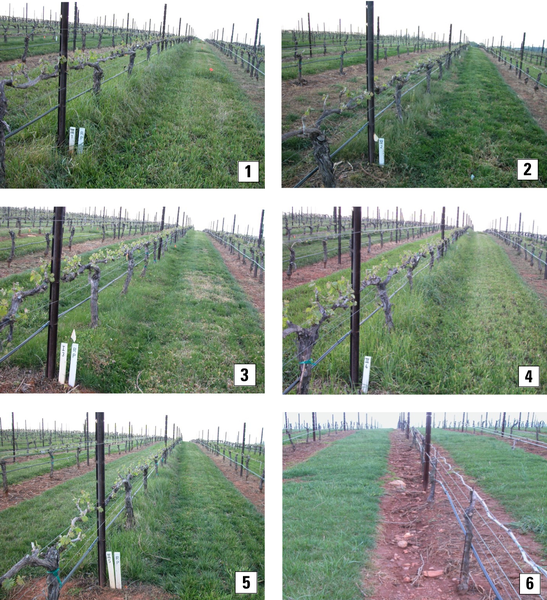
Figure 2. Five grasses as under trellis cover crops and a herbicide-treated vine row, just prior to, or after “budbreak” in April 24, 2007. 1: KY-31 fescue; 2: Aurora Gold fescue; 3: perennial rye grass; 4: orchard grass; 5: Elite-II turf-type fescue; 6: herbicide treated control.
Source: Gill Giese, Arkansas State University
Impact of UTCC on Yield and Vegetative Growth
The competitive impact of cover crops on yield and vegetative growth of a given cultivar/rootstock grapevine partially depends on environmental factors, water and nutrient availability. Consequently, regional long-term studies such as the study described here are necessary for making science-based cover crop recommendations that are useful to growers and applied researchers. In this study, all UTCC treatments consistently reduced vine pruning weights from 2006 to 2015 (Figures 4 and 5), despite differing weather conditions. Although fluctuations in vine pruning weights were observed over time (Figure 4), vine pruning weights in the UTCC-treated groups were reduced up to 30% compared to the herbicide treatment (Figure 5).
The average yield over the duration of the study was between 4.04 tons/acre (KY-31 fescue) and 4.61 tons/acre (Aurora Gold fescue). The weed free herbicide strip yielded on average 4.43 tons/acre, perennial rye grass 4.45 tons/acre, orchard grass 4.21 tons/acre, and Elite II fescue on average 4.32 tons/acre. Although the yields were not statistically different, in practice, growers must carefully consider any effects of cultural practices on yields.
Average pruning weights were reduced in all treatments between 20% (annual rye grass) and 30% (Elite II fescue, as shown in Figure 5). This means that, depending on the specific vigor control goals in a vineyard, some cover crops can be used as UTCC to effectively reduce herbicide applications and improve the vine balance. This recommendation is supported by the positive effect of all UTCC treatments on the average fruit-to-wood ratio, the balance of the fruit mass, and vine canopy size. This ratio is calculated by comparing yield at harvest to the dormant pruning weight measured in the winter after harvest; crop load = vine yield / dormant pruning weight. This unitless ratio, known as the Ravaz Index (Ravaz, 1903 as cited in Skinkis and Vance 2013), was calculated over the course of the study. All UTCC improved this ratio to a more optimal range, as compared to the herbicide treatment (3.43). However, only the Elite II fescue treated vines achieved a Ravez index (5.12) (Figure 6) within the optimal range of 5 to 10 (as shown in Table 2 ).

Figure 6. Average Ravaz Index (crop yield/pruning weight) of Cabernet Sauvignon/SO4 grown with under trellis cover crop or herbicide treated vine row, Yadkin Valley, North Carolina, 2005-2010. Columns with different letters are significantly different (P<0.05).
Source: Gill Giese, Arkansas State University
Impact of UTCC on Vine Architecture and Fruit Chemistry
No more than 1.5 leaf layers are desired in the vine canopy, especially in a vertical shoot position - trained canopy. While all vines had less than 1.5 leaf layers, no treatment vines in the North Carolina study achieved canopy architecture benchmarks of < 20% shaded leaves, < 20% shaded clusters, or > 20% canopy gaps (Smart, Robinson, and the Ministry of Agriculture and Fisheries 1991). However, vines exposed to Elite II fescue had the most favorable measured values in all categories. As vine size and vigor were reduced by exposure to Elite II fescue, fruit exposure was increased by an average of 12.5% compared to vines in the herbicide plots (Table 3). Seasonal differences were evident, with the more dry years having a more favorable effect on all metrics. Overall, vines exposed to KY-31 or Elite II fescue had lower dormant pruning weights and less dense vine canopies without significant yield reductions relative to vines with the herbicide treatment. See Figure 7.
There was little or no reduction of total yield from the use of UTCC. Using UTCC effectively reduced excessive vine growth without compromising yield. Primary fruit chemistry such as pH, titratable acidity, and soluble solids were not affected by UTCC treatments between 2005 and 2011 (Table 4). Fruit from UTCC treated vines had consistently and significantly lower, and arguably more optimal YAN (yeast assimilable nitrogen) and petiole nitrogen levels compared to vines exposed to the herbicide strip (Table 4). Since YAN levels higher than 200 mg N/L can be a problem in North Carolina fruit, optimization of YAN levels is often as desired as vigor control in a vineyard.
Management of UTCC in a Vineyard
Seeding and soil preparation
Seeding and soil preparation are the most labor and cost intensive steps in UTCC management. It is best to start a UTCC on a 2 to 4 ft wide weed-free under trellis strip centered on the vine row. Relatively weed-free under trellis strips can be achieved with herbicide applications (glyphosate) or through the use of special equipment (under vine cultivators) as seen in Figure 8 (Moretti, 2021). Under vine mowing is not sufficient for successful UTCC stand establishment in most North Carolina vineyards. Cover crops should be sown only after a weed-free under trellis strip is achieved. For most cover crop species in North Carolina vineyards, the best seeding time is late summer to early fall to ensure adequate establishment and growth before cold weather and possibly freezing temperatures. Seeding can be done by hand on a small acreage, or with under-vine seeding equipment.
Management during Establishment
After being established, most UTCC require relatively low management. In general, managing UTCC growth involves preventing its growth into the vine’s fruit zone. This is especially important in vertical shoot positioned (VSP) trellis systems with fruiting wires that are positioned at relatively low levels. Low growing grasses may require a single under vine mowing pass per season, while the taller grasses might need multiple passes. Some growers choose to terminate UTCC each year by using selective herbicides (clethodim, or the trade name Select) and re-establishing the cover crop the following year. Young vines should be put in vine shelters during the growing season to prevent potential herbicide or mowing damage to the trunks.
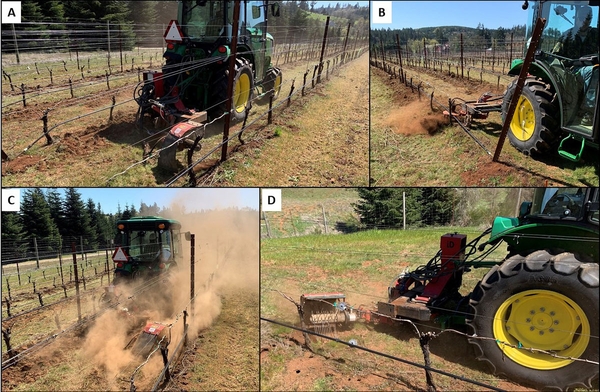
Figure 8. On-farm study evaluating an under vine cultivator in Turner, Oregon (Spring 2021). A: Undervine cultivation in a mature cane pruned vineyard at vine level. B: Undervine cultivation in between vines. C: Dry conditions can cause dust. D: Close-up of an under vine cultivator
Photos by Marcelo Moretti, Oregon State University.
Conclusion
Under trellis cover crops (UTCC) are a viable management option for improving vine balance, controlling excessive vine vigor, and optimizing YAN (yeast assimilable nitrogen) in fruit at harvest from North Carolina vineyards. This long-term research has shown that perennial grasses used as UTCC substantially reduce the need for vineyard herbicides, and can reduce labor costs and extend vineyard longevity through reduced erosion, enhanced soil health, and other ecosystem services. Such outcomes create marketing opportunities for wines that are relatively more sustainable. The use of UTCC improves balance without a yield penalty, and is especially effective with highly vigorous scion/rootstock combinations grown in North Carolina. While cover crop choice remains a site-specific endeavor, we confidently recommend several perennial grass species for North Carolina vineyards.
Acknowledgments
The authors wish to acknowledge Shelton Vineyards (Dobson, NC) and Raffaldini Vineyards (Ronda, NC) for their continuous support of this study. We further want to thank Marcelo Moriette from Oregon State University for supplying additional pictures used in this publication.
Resources
Centinari, Michaela. 2016. “Getting the Full Benefit of Under-Vine Cover Crop.” Kalamazoo, Michigan: Show Me Grape and Wine Conference and Symposium.
Nita, Mizuho (Ed.). 2021. 2021 Southeast Regional Bunch Grape Integrated Management Guide. Southern Region Small Fruit Consortium.
NC State Extension. 2023, February 1. 2023 North Carolina Agricultural Chemicals Manual. Publication AG-1. Raleigh, NC: NC State Extension.
Skinkis, Patty. 2019, June 19. “Basic Concept of Vine Balance.” Kansas City, Missouri: Extension Foundation.
Sustainable Agriculture Research and Education (SAFE). 2012. Managing Cover Crops Profitably. 3rd ed. College Park, MD: SARE.
Wise, Alice and Hans Walter-Peterson. 2018. "Expanding the Use of Under-Vine Cover Crops in New York Vineyards.” Research Focus 2018-2: Cornell Viticulture and Enology.
Wolf, Tony K., Also H. Smith Jr., and Will Giese. 2020. Floor Management Strategies for Virginia Vineyards. VCE Publication SPES-209P. Blacksburg, VA: Virginia Cooperative Extension.
References
Centinari, M., J.E. Vanden Heuvel, M. Goebel, M.S. Smith, and T.L. Bauer. 2016. “Root-zone Management Practices Impact Above and Belowground Growth in Cabernet Franc Grapevines.” Australian Journal of Grape Wine Research 22, no. 1: 137–148.
Chou, Ming Yi, and Justine E. Vanden Heuvel. 2018. “Annual Under-Vine Cover Crop Mitigate Vine Vigor in a Mature and Vigorous Cabernet Franc Vineyard.” American Journal of Enology and Viticulture 70: 98-108.
Coniberti, Andres, Virginia Ferrari, Edgardo Disegna, Mario Garcia Petillo, and Alan N. Lasko. 2018. “Complete Vineyard Floor Cover Crop to Reduce Grapevine Susceptibility to Bunch Rot.” European Journal of Agronomy 99:167-176.
Giese, Gill, Ciro Velasco-Cruz, Lucas Roberts, Josh Heitman and Tony K. Wolf. 2014. “Complete Vineyard Floor Cover Crops Favorably Limit Grapevine Vegetative Growth.” Scientia Horticulturae. 170: 256-266.
Giese, Gill, Tony. K. Wolf, Ciro Velasco-Cruz, Lucas Roberts, and Josh Heitman. 2015. “Cover Crop and Root Pruning Impacts on Vegetative Growth, Crop Yield Components and Grape Composition of Cabernet Sauvignon.” American Journal of Enology and Viticulture 66: 212-226.
Giese, Gill, Tony K. Wolf, Ciro Velasco-Cruz, and Lucas Roberts. 2016. “Cover Crop and Root Pruning Effects on The Rooting Pattern of SO4 Rootstock Grafted to Cabernet Sauvignon.” American Journal of Enology and Viticulture 67: 105-115.
Hatch, Tremain A., Cain C. Hickey, and Tony. K. Wolf. 2011. “Cover Crop, Rootstock and Root Restriction Regulate Vegetative Growth of Cabernet Sauvignon in a Humid Environment.” American Journal of Enology and Viticulture 62, no. 3: 298-311.
Hickey, Cain C., Tremain.A. Hatch, Jonathon Stallings and Tony K. Wolf. 2016. “Under-Trellis Cover Crop and Rootstock Affect Growth, Yield Components, and Fruit Composition of Cabernet Sauvignon.” American Journal of Enology and Viticulture 67: 281-295.
Holland, S., A. Howard, J.L. Heitman, T.J. Sauer, W. Giese, T.B. Sutton, N. Agam, A. Ben-Gal, and J. Havlin. 2014. “Implications of Tall Fescue for Inter-Row Water Dynamics in a Vineyard.” Agronomy Journal 106, no. 4:1267-1274.
Karl, A., I.A. Merwin, M.G. Brown, R. A. Hervieux, and J.E. Vanden Heuvel. 2016. “Impact of Undervine Management on Vine Growth, Yield, Fruit Composition, and Wine Sensory Analyses in Cabernet Franc.” American Journal of Enology and Viticulture 67, no.3: 269-280.
Kliewer, W. M., and R. J. Weaver. 1971. “Effect of Crop Level and Leaf Area on Growth, Composition, and Coloration of `Tokay' Grapes.” American Journal of Enology and Viticulture 22: 172-177.
Moretti, Maecelo. 2021, July 14. “Mechanical Weed Control Under the Vine.” Washington: Washington State University.
Skinkis, Patricia A., and Amanda J. Vance. 2013. “Understanding Vine Balance: An Important Concept in Vineyard Management.” EM 9068. Corvallis, OR: Oregon State University Extension Service.
Smart, Richard, Mike Robinson, and the Ministry of Agriculture and Fisheries, New Zealand. 1991. Sunlight into Wine: A Handbook for Winegrape Canopy Management. Adelaide, Australia: Winetitles.
Publication date: May 18, 2023
AG-943
N.C. Cooperative Extension prohibits discrimination and harassment regardless of age, color, disability, family and marital status, gender identity, national origin, political beliefs, race, religion, sex (including pregnancy), sexual orientation and veteran status.

